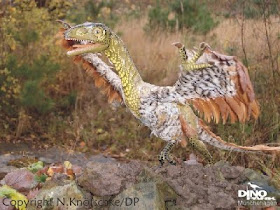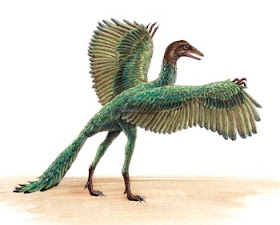
Above: What has mankind done to deserve this?
Sorry for the lack of posts lately. Just moved countries again (itchy feet need scratching) and settling into a new full-time teaching job. Also, any free time I've had over the last week or so has been spent on drawing, rather than blogging, dinosaurs. Rest assured those two will overlap. I've been meaning for a while to put together a guide to the wing anatomy of Mesozoic birds which will probably first appear on DinoGoss. This is for the good of the world, since it's insanely rare even in this day and age of the exquisitely preserved Jehol biota to find amateur (or sometimes professional!) paleoartists getting prehistoric birds right. I think they suffer from 'background syndrome'--birds, like pterosaurs, usually appear in the background in paintings starring more glamorous megafauna. Thus artists don't pay them much attention, thus they're prone to getting basic details wrong, which everyone else copies.
Actually, maybe that's the more important point. The copying, that is. Google Image Search syndrome is plaguing paleoart. Do a search for any prehistoric bird/basal aviremigian, and the first page of hits will all be inaccurate drawings. People looking for references but not wanting to do actual research will copy those mistakes, and they keep getting perpetuated, which keeps the same inaccuracies on the top Google hits, forever. Depressing, no? For example, on one forum, a young artist recently showed off a really well made, life-sized sculpture of Caudipteryx. Unfortunately, his research was obviously done by browsing Google, and he used this terribly inaccurate illustration as the basis for the model.
Thus, the reason for this new series, "You're Doing It Wrong." That and it's something I can write up quickly using only Google research. I'll start with one of the worst dinobird Google offenders, and the one for which there is the absolute least amount of wiggle room for excuses: Archaeopteryx.
1. How Bad Is It?
Google Image search "Archaeopteryx," and of the first 18 hits, 5 are photos of specimens, 2 are diagrams with labelled anatomy, and the rest are artist's impressions. Of those 11 illustrations, 0 are anatomically accurate. Count 'em: ZERO! That's pretty bad you guys.
2. What's the problem?
Some are better than others. Three of the images, one by pro Todd Marshall, get minor details wrong. In the Marshall one, all the proportions looks correct, it's just that the primary feathers seem to be coming off the wrist rather than the finger. This is a common mistake, but at least an entire, ill-proportioned, scaly hand isn't poking anteriorly from a feathered wing where the feathers apparently anchor to nothing, like some of the other results. The second "ok" one has the same problem, plus the presence of tertial feathers. If you're posing your Archie with an outstretched humerus, there should be a gap in between the wing and the body. This is even true of most modern birds! Yet it's probably the number one common mistake in drawing Mesozoic avialans. The third, by T. Mike Keesey, has the arms lifted too high above the body, an anatomical impossibility.
This model, from Wikipedia, is pretty good minus the naked legs. We know now that Archie actually had quite long feathers on the legs down at least to the ankle. (UPDATE: I had originally included "blue iridescent color on the head" as an error here. However, recent research suggests that the apparent filamentous nature of the contour feathers in many fossils is probably a taphonomic artifact, so it's entirely possible Archie had pennaceous body and head feathers, allowing iridescence and other structural colors).

 Some suffer from more than minor inaccuracies. Images like those above should not be allowed in the 21st Century. Reversed hallux, hands decoupled from the wing, scaly head and neck, etc. Then there's this one, that even says Archaeopteryx had a horny beak... wtf?
Some suffer from more than minor inaccuracies. Images like those above should not be allowed in the 21st Century. Reversed hallux, hands decoupled from the wing, scaly head and neck, etc. Then there's this one, that even says Archaeopteryx had a horny beak... wtf?
3. What's the excuse?
There isn't one. Entire papers have been published explaining the anatomy and plumage of Archaeopteryx in great detail. It's one of the best-studied, if not THE best-studied, Mesozoic bird, period. Aside from color, we know just about everything there is to know about this creatures appearance. Not to mention, one of the top Google hits is a fairly acceptable diagram showing how the feathers attached and the proportions of all the bones. Of course, this is counter-acted by a completely crap diagram further down the page that barely looks like a theropod, let alone Archaeopteryx. Of course, this is on a much more popular web page, and ostensibly an "educational" one, Enchanted Learning.
4. What's to be done?
Research, I should hope! Get a good photo of the fossil, or even better, a copy of Christiansen & Bonde's 2004 paper "Body plumage in Archaeopteryx: a review, and new evidence from the Berlin specimen." Stop copying the images done in the past, even if by notable artists--they're probably wrong in at least some minor respect. And study the drawings done by Reichel in the 1940s, which are still extremely accurate, especially in terms of plumage arrangement.
Till next time gosshounds!


I almost literally jumped for joy when I saw that you were going to begin a series of drawing guides for maniraptors.
ReplyDeleteAlso, Archaeopteryx had a deinonychosaur esque retractable second toe, too, right?
What really sucks is that I made a better one: http://www.flickr.com/photos/keesey/1095769990/in/set-72157600607422987/
ReplyDelete...but it doesn't come up on Google. (The better one still has the same problem, albeit mitigated.)
Actually what's worse about http://www.enchantedlearning.com/agifs/Archaeopteryx_bw.GIF is the mislabeled 'calf' and 'thigh'...
ReplyDeleteSorry, but its not as easy as you imply - as viewed by the hobby artist who is likely to contribute their material to the google world. Even accessing the pdf you recommend... abstract yes, charts and pdf... US $ 31.50.
ReplyDeleteFor the non-trained paleoartist you seem to be addressing, contact to the scientists is crucial. Your blog and many others are a great resource (thanks for this!) as well as the dinosaur mailing list and open source journals such as those linked to at the OpenDino project (http://opendino.wordpress.com/get-papers/). Even this is something to be enjoyed at your own risk as the specialists have some widely divergent views themselves.
I'm currently tackling a Stegosaurus and can say that what you are asking turns an evening doodle into a full-time job. Only to drown in uninformed doodles of others.
How about having a press section at one of these open source sections with illustrations commented by the pros and tagged as metadata to the gallery?
Albertonykus: Yes, the Thermopolis specimen shows Archie has a hyperextendible second toe, though the claw isn't nearly as enlarged as in dromaeosauids. I don't think it's clear that Archie would have habitually held the toe clear of the ground 24/7 as derived dromaeosaurs apparently did (especially when climbing, if it climbed).
ReplyDeletedavidmaas: I agree papers can be trickier to come by for non-professionals, but not impossible. If you can get to a library (especially a university library) you can usually pull papers from most major journals from their systems (the payed access stuff dissapears from the site, or you'd have to use their journal search). Failing that, you could always email one of the authors, who I hear are happy to provide pdfs.
And I don't think doodling is a full time research job, especially for well-known animals like Stegosaurus. You can probably find plenty of accurate skeletal restorations to base your drawing on, where others have already done all the research for you. Just remember a new paper came out the other day showing almost all skeletal mounts of stegosaurs are wrong, because their hands were vertical, tubular columns like sauropods rather than splayed-out fingers like ceratopsians ;)
Great post!
ReplyDeleteRegarding your comment about stegosaur hands. I have just had a quick look at the paper. The vertical arangment is what Scott Hartman and Greg Paul have been doing their stegosaur skeletals. Both stegosaur metatarsals and ceratopsian mets are vertical.
The difference between the two groups is that the mets in ceratopsians (well, triceratops) form an 'L' shape in top view, as opposed to a 'C' shape in stegos.
Another difference is that ceratopsians have longer fingers, which is what causes the ''splayed-out'' look.
Very typical of the web nowadays.
ReplyDeleteNo-one appears to address the issue of the feathers on the hind legs/feet either.
Nice tips, I didn't know that so much was known. I had no idea about the thing on feather structure constraining the possible colors. And, speaking of colors, and still about Archaeopteryx and copying what others have done, I have the impression that its most popular colors for Archie are blue and yellow. I think it may have been started by Zedenek Burian.
ReplyDeletethe first pic was u-g-l-y poop!!!!!!!!!!
ReplyDeleteThere's also the tradition of putting an extant Ginkgo biloba into the picture. Jurassic ginkgos had different leaves and different fruits.
ReplyDeleteZedenek
Zdeněk.
This comment has been removed by the author.
ReplyDelete@David Marjanović
ReplyDeleteThat's true, I believe _Ginkgo yimaensis_ would have been around at that time (though not necessarily at Solnhofen). One thing I'm unclear on is, in recent papers on Mesozoic ginkgo diversity like this one http://www.sciencedirect.com/science/article/pii/S0034666704000454 , it's stated that modern style _G. biloba_ was indeed not present. But in The Jehol fossils, I think, there is a large photo of a really nice ginkgo leaf impression that looks identical to the modern species. Any idea what's going on there?
Hoping to get back to this project and finish it up (in case it's not on your radar). Scott Hartman's been consulting... has been a wonderful experience.
ReplyDeletehttp://www.drip.de/?p=1469
Any idea where there might be a good bundle of illustrations? Saturdays on my blog are devoted to considering the accuracy of illustrations for the animal of the week and its Archaeopteryx this week. I don't want to toss out crappy illustrations and praise them based on my opinion. I look at the skeleton first, but I was interested to see if there was a good source before I go searching tonite.
ReplyDelete@The Savvypenguin
ReplyDeleteI would check out the #Deinonychosauria group at DeviantArt: For the most part, submitted images are pretty accurate, and there are a number of them depicting Archie (most of the newer ones even show it with the correct black coloration of the wing feathers which has recently been discovered).
http://deinonychosauria.deviantart.com/gallery/31722678
Thanks, I'll check it out!
ReplyDeleteOh, also, Enchanted Learning diagrams always look like crap, don't be disheartened, I think they may have a child draw them for the website.
ReplyDelete